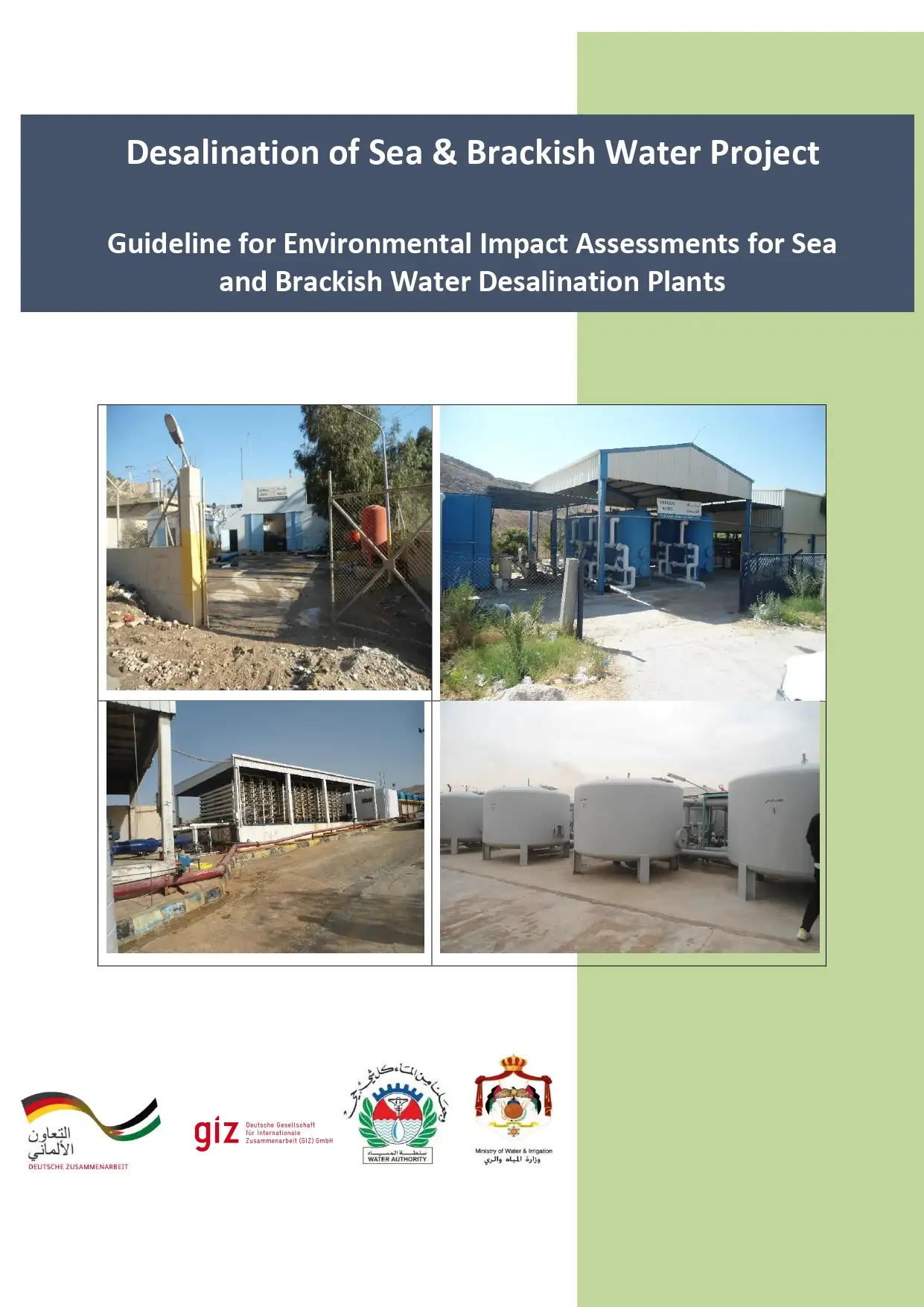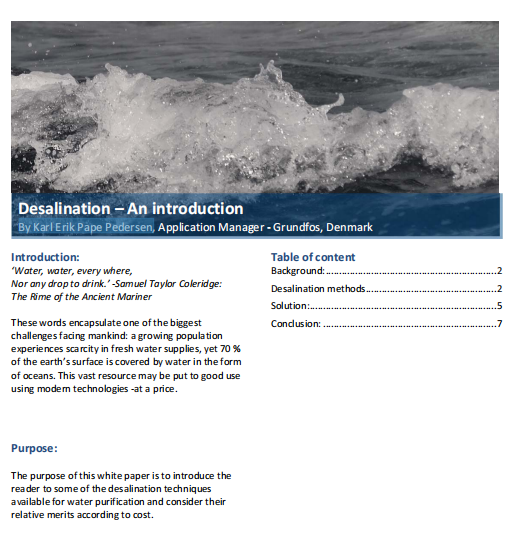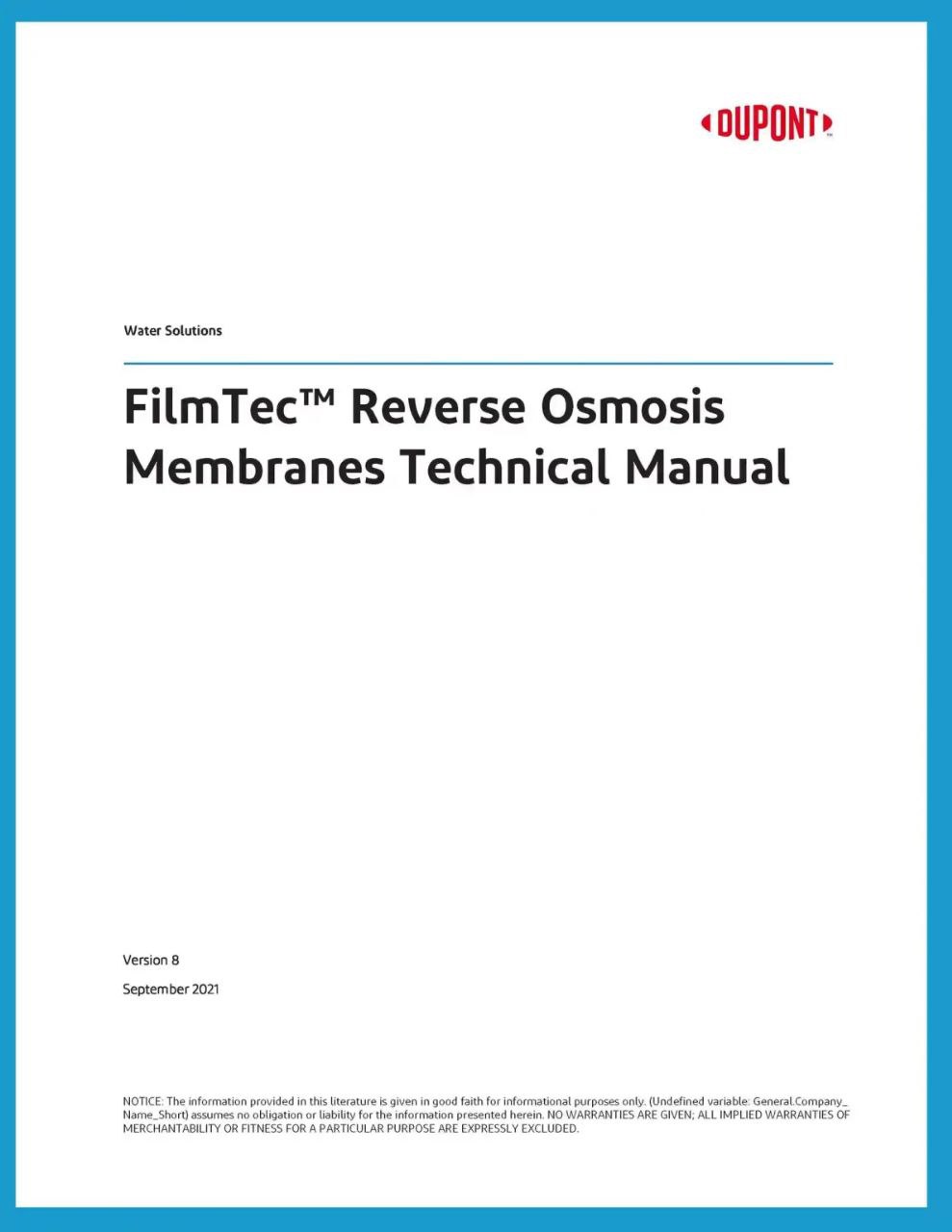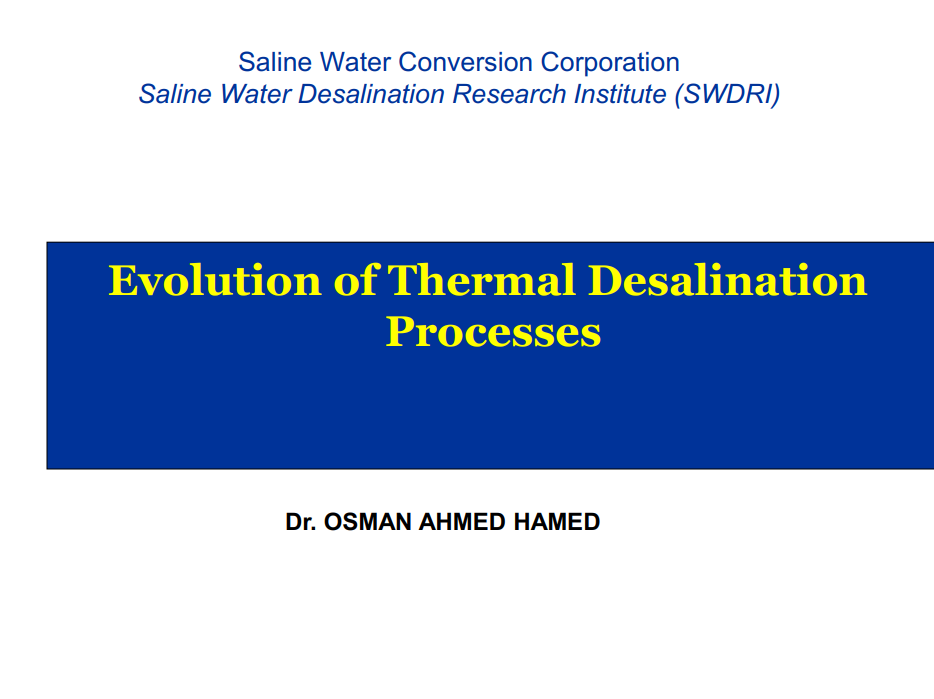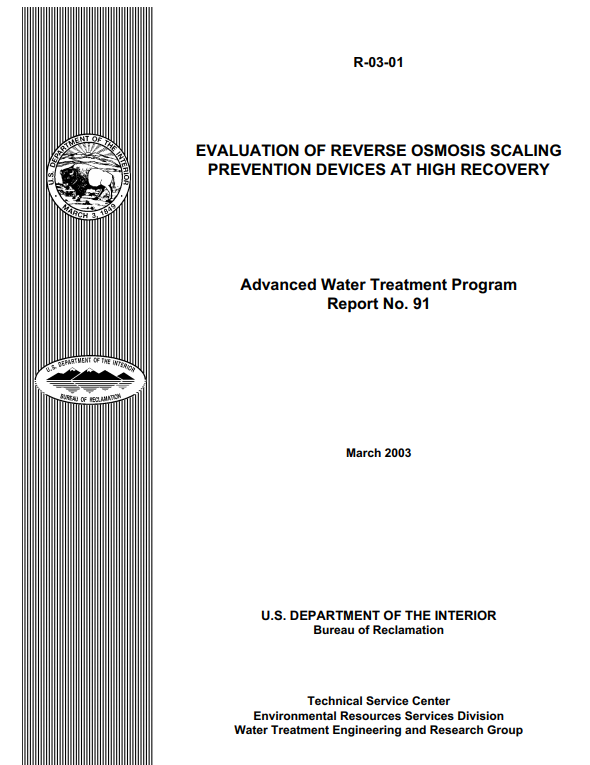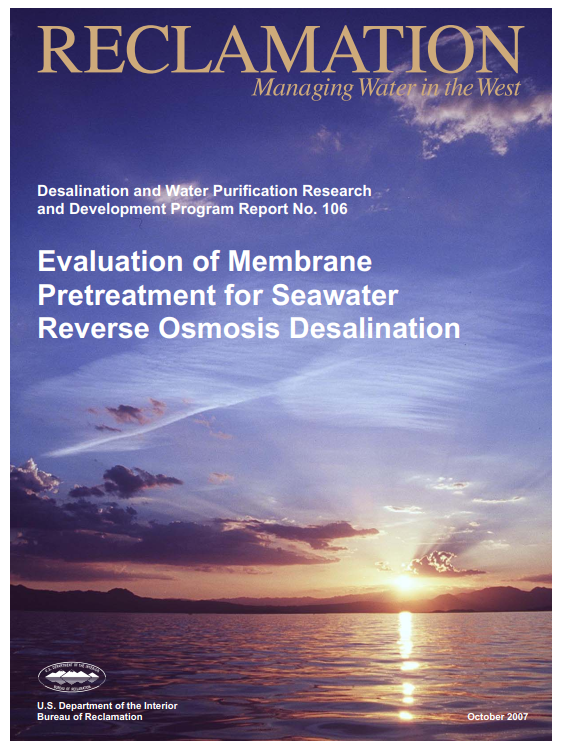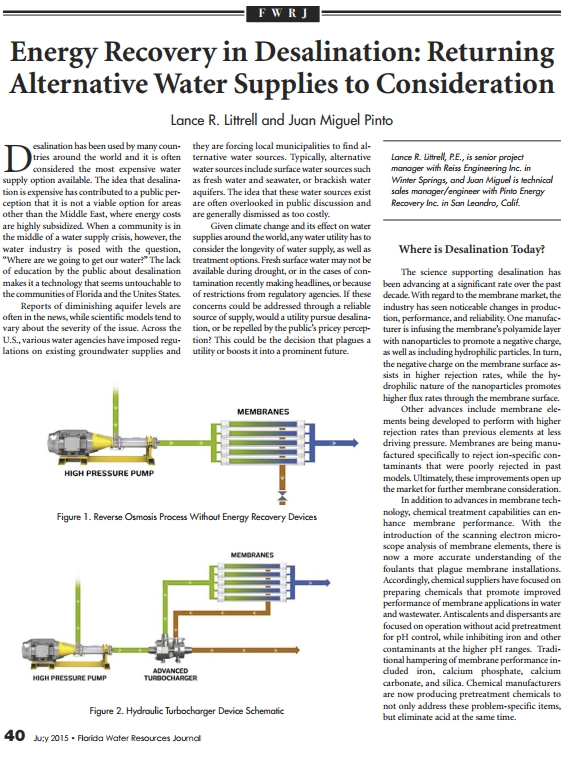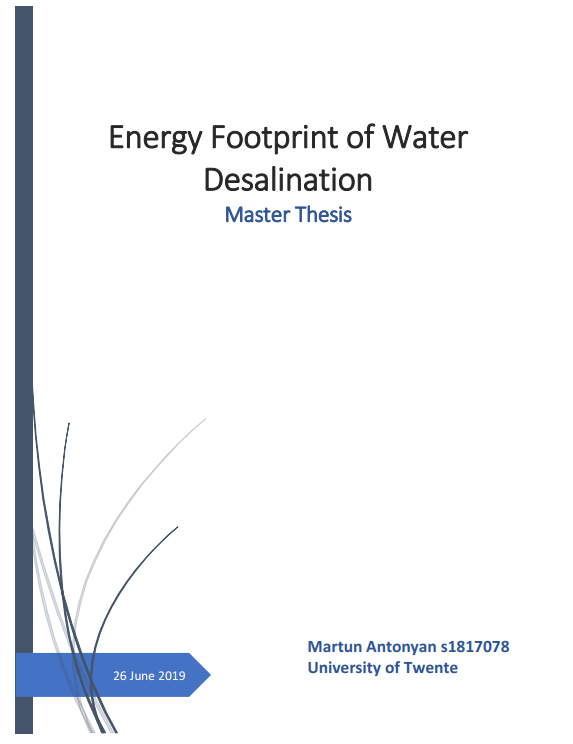Desalination of Sea & Brackish Water Project
Introduction:
Desalination projects require an Environmental and Social Impact Assessment (ESIA) study to determine the potential impacts a project can have on the environment. The “ESIA” considers all environmental pathways. It evaluates the potential impacts on air, land, and marine environments and proposes mitigation measures to reduce environmental impacts. The potential impacts of desalination plants are different from the environmental impacts of other facilities. In particular, the brine discharge from desalination plants can have huge impacts. Therefore, it is proposed by this document to follow a dedicated routine in the ESIA process for brackish and seawater desalination plants. An “ESIA” needs to cover the following stages of a project which are: the construction; the operation, and the decommissioning stages. During the construction stage, the construction process can be time-consuming, inconvenient, loud, destructive, and disruptive to the environment. It is ideal to have as little impact from the construction as necessary. If used water resources, connections to services, and water infrastructure are near the proposed plant site, then there will be fewer constructional interventions required and thus less potential environmental damages would occur. When construction begins, the party responsible for follow-up on the ESIA needs to monitor according to the Environmental Management Plan issues identified in the ESIA so that the agreed plan is implemented and followed. For the operation stage, the “ESIA” report discusses the chosen desalination process, the emissions process will generate, the implications the facility will have on the environment, the considerations to be made about the energy supply, the benefits the facility will have on the local community from a socio-economic perspective, and the proposed mitigation measures to reduce problems associated with the facility. It is even more important to monitor all aspects addressed in the ESIA’s Environmental Management Plans (EMP) during the operational stage to ensure consistent compliance with agreed permittable environmental impacts
Desalination of Sea & Brackish Water Project
Introduction:
Desalination projects require an Environmental and Social Impact Assessment (ESIA) study to determine the potential impacts a project can have on the environment. The “ESIA” considers all environmental pathways. It evaluates the potential impacts on air, land, and marine environments and proposes mitigation measures to reduce environmental impacts. The potential impacts of desalination plants are different from the environmental impacts of other facilities. In particular, the brine discharge from desalination plants can have huge impacts. Therefore, it is proposed by this document to follow a dedicated routine in the ESIA process for brackish and seawater desalination plants. An “ESIA” needs to cover the following stages of a project which are: the construction; the operation, and the decommissioning stages. During the construction stage, the construction process can be time-consuming, inconvenient, loud, destructive, and disruptive to the environment. It is ideal to have as little impact from the construction as necessary. If used water resources, connections to services, and water infrastructure are near the proposed plant site, then there will be fewer constructional interventions required and thus less potential environmental damages would occur. When construction begins, the party responsible for follow-up on the ESIA needs to monitor according to the Environmental Management Plan issues identified in the ESIA so that the agreed plan is implemented and followed. For the operation stage, the “ESIA” report discusses the chosen desalination process, the emissions process will generate, the implications the facility will have on the environment, the considerations to be made about the energy supply, the benefits the facility will have on the local community from a socio-economic perspective, and the proposed mitigation measures to reduce problems associated with the facility. It is even more important to monitor all aspects addressed in the ESIA’s Environmental Management Plans (EMP) during the operational stage to ensure consistent compliance with agreed permittable environmental impacts
Desalination – An introduction
Introduction:
Water, water, every where, Nor any drop to drink.’ ‐Samuel Taylor Coleridge: The Rime of the Ancient Mariner These words encapsulate one of the biggest challenges facing mankind: a growing population experiences scarcity in fresh water supplies, yet 70 % of the earth’s surface is covered by water in the form of oceans. This vast resource may be put to good use using modern technologies ‐at a price.
Desalination – An introduction
Introduction:
Water, water, every where, Nor any drop to drink.’ ‐Samuel Taylor Coleridge: The Rime of the Ancient Mariner These words encapsulate one of the biggest challenges facing mankind: a growing population experiences scarcity in fresh water supplies, yet 70 % of the earth’s surface is covered by water in the form of oceans. This vast resource may be put to good use using modern technologies ‐at a price.
Forward Osmosis
Abstract:
Fresh, potable water is an essential human need and thus looming water shortages threaten the world’s peace and prosperity. Waste water, brackish water, and seawater have great potential to fill the coming requirements. Unfortunately, the ability to exploit these resources is currently limited in many parts of the world by both the cost of the energy and the investment in equipment required for purification/desalination. Current research suggests that forward osmosis is a novel, low-energy, and thus low cost method of desalination and developing practical draw solutions can improve the efficiency of this process.
To address these limitations, this study focuses on forward osmosis technology, its effective operational conditions chosen wisely based on the membrane to be used and the streams to be treated and providing a feasible economic estimation
Forward Osmosis
Abstract:
Fresh, potable water is an essential human need and thus looming water shortages threaten the world’s peace and prosperity. Waste water, brackish water, and seawater have great potential to fill the coming requirements. Unfortunately, the ability to exploit these resources is currently limited in many parts of the world by both the cost of the energy and the investment in equipment required for purification/desalination. Current research suggests that forward osmosis is a novel, low-energy, and thus low cost method of desalination and developing practical draw solutions can improve the efficiency of this process.
To address these limitations, this study focuses on forward osmosis technology, its effective operational conditions chosen wisely based on the membrane to be used and the streams to be treated and providing a feasible economic estimation
Reverse Osmosis Membranes Technical Manual
Introduction:
To increase the efficiency and life of reverse osmosis and nanofiltration (RO/NF) systems, effective pretreatment of the feedwater is required. Selection of the proper pretreatment will maximize efficiency and membrane life by minimizing:
- Fouling
- Scaling
- Membrane degradation
Reverse Osmosis Membranes Technical Manual
Introduction:
To increase the efficiency and life of reverse osmosis and nanofiltration (RO/NF) systems, effective pretreatment of the feedwater is required. Selection of the proper pretreatment will maximize efficiency and membrane life by minimizing:
- Fouling
- Scaling
- Membrane degradation
Evaluation Of Reverse Osmosis Scaling Prevention Devices At High Recovery
Abstract:
This study evaluated the effectiveness of a magnetic device (MD) and a high voltage capacitance device (HVC) as possible alternatives to the dosing of chemical antiscalants for preventing scaling during reverse osmosis (RO) operation at high product water recovery. The tests were conducted on feed water to the Bureau of Reclamation’s 72-MGD Yuma Desalting Plant located in Yuma AZ. High overall recoveries of greater than 90 percent were achieved by operating a two-stage 4-gal/min RO pilot unit (membrane unit 1 [MU1]) on the concentrate from a 200-gal/min RO unit operating at a water recovery of 70-percent. In these tests, neither the MD nor the HVC were effective in preventing calcium sulfate scaling at 91-percent water recovery. In contrast, the addition of 2 mg/L of sodium hexametaphosphate (SHMP) to MU1 feed water was successful in avoiding scale at recoveries of 93 percent. Dosing of SHMP (or other chemical antiscalant) remains the recommended method for achieving high recovery operation without scaling at the Yuma Desalting Plant.
Evaluation Of Reverse Osmosis Scaling Prevention Devices At High Recovery
Abstract:
This study evaluated the effectiveness of a magnetic device (MD) and a high voltage capacitance device (HVC) as possible alternatives to the dosing of chemical antiscalants for preventing scaling during reverse osmosis (RO) operation at high product water recovery. The tests were conducted on feed water to the Bureau of Reclamation’s 72-MGD Yuma Desalting Plant located in Yuma AZ. High overall recoveries of greater than 90 percent were achieved by operating a two-stage 4-gal/min RO pilot unit (membrane unit 1 [MU1]) on the concentrate from a 200-gal/min RO unit operating at a water recovery of 70-percent. In these tests, neither the MD nor the HVC were effective in preventing calcium sulfate scaling at 91-percent water recovery. In contrast, the addition of 2 mg/L of sodium hexametaphosphate (SHMP) to MU1 feed water was successful in avoiding scale at recoveries of 93 percent. Dosing of SHMP (or other chemical antiscalant) remains the recommended method for achieving high recovery operation without scaling at the Yuma Desalting Plant.
Evaluation of Membrane Pretreatment for Seawater Reverse Osmosis Desalination
Abstract:
This project was undertaken to better understand the technical and cost implications of the use of membrane filtration as pretreatment for seawater reverse osmosis (RO). The pilot study was conducted using raw feed water from the Corpus Christi Bay in Texas, at the San Patricio Municipal Water District facility. The pilot study consisted of a side-by-side comparison of membrane filtration and conventional filtration, both followed by separate RO pilot systems, testing over an approximate 1-year period. The results indicate that membrane filtration produced far superior water quality for pretreatment, measured by reduced turbidity and by the silt density index (SDI). The resulting impact on the RO performance was a significantly lower RO cleaning frequency. The economic evaluation indicates that on a life-cycle cost analysis, the total water cost (TWC) for a plant using membrane filtration is 4-8% less than a plant using media filtration.
Evaluation of Membrane Pretreatment for Seawater Reverse Osmosis Desalination
Abstract:
This project was undertaken to better understand the technical and cost implications of the use of membrane filtration as pretreatment for seawater reverse osmosis (RO). The pilot study was conducted using raw feed water from the Corpus Christi Bay in Texas, at the San Patricio Municipal Water District facility. The pilot study consisted of a side-by-side comparison of membrane filtration and conventional filtration, both followed by separate RO pilot systems, testing over an approximate 1-year period. The results indicate that membrane filtration produced far superior water quality for pretreatment, measured by reduced turbidity and by the silt density index (SDI). The resulting impact on the RO performance was a significantly lower RO cleaning frequency. The economic evaluation indicates that on a life-cycle cost analysis, the total water cost (TWC) for a plant using membrane filtration is 4-8% less than a plant using media filtration.
Energy Recovery in Desalination: Returning Alternative Water Supplies to Consideration
Abstract:
Desalination has been used by many countries around the world and it is often considered the most expensive water supply option available. The idea that desalination is expensive has contributed to a public perception that it is not a viable option for areas other than the Middle East, where energy costs are highly subsidized. When a community is in the middle of a water supply crisis, however, the water industry is posed with the question, “Where are we going to get our water?” The lack of education by the public about desalination makes it a technology that seems untouchable to the communities of Florida and the Unites States. Reports of diminishing aquifer levels are often in the news, while scientific models tend to vary about the severity of the issue. Across the U.S., various water agencies have imposed regulations on existing groundwater supplies and they are forcing local municipalities to find alternative water sources. Typically, alternative water sources include surface water sources such as fresh water and seawater, or brackish water aquifers. The idea that these water sources exist are often overlooked in public discussion and are generally dismissed as too costly. Given climate change and its effect on water supplies around the world, any water utility has to consider the longevity of water supply, as well as treatment options.
Energy Recovery in Desalination: Returning Alternative Water Supplies to Consideration
Abstract:
Desalination has been used by many countries around the world and it is often considered the most expensive water supply option available. The idea that desalination is expensive has contributed to a public perception that it is not a viable option for areas other than the Middle East, where energy costs are highly subsidized. When a community is in the middle of a water supply crisis, however, the water industry is posed with the question, “Where are we going to get our water?” The lack of education by the public about desalination makes it a technology that seems untouchable to the communities of Florida and the Unites States. Reports of diminishing aquifer levels are often in the news, while scientific models tend to vary about the severity of the issue. Across the U.S., various water agencies have imposed regulations on existing groundwater supplies and they are forcing local municipalities to find alternative water sources. Typically, alternative water sources include surface water sources such as fresh water and seawater, or brackish water aquifers. The idea that these water sources exist are often overlooked in public discussion and are generally dismissed as too costly. Given climate change and its effect on water supplies around the world, any water utility has to consider the longevity of water supply, as well as treatment options.
Energy Footprint Of Water Desalination
Abstract:
Demand for the freshwater is growing due to the growth of world population that entails growing demand of freshwater for agricultural and industrial purposes. However, the fresh water availability on Earth is limited and many countries face severe water shortages. Water desalination could be a possible solution for this problem. Among the variety of existing water desalination technologies, three are particularly promising, these are: reverse osmosis (RO), multi stage flash (MSF), multi effect distillation (MED). Energy consumption of desalination processes are determined by factors like capacity of desalination plant (small, medium, large), the energy source (electricity vs thermal), type of feed water (brackish (BW) vs seawater (SW)), desalination method (thermal vs membrane), use of renewable energy sources (solar, wind, geothermal), and necessity of feed pretreatment (mechanical and/or chemical). In this paper, I compare the total energy consumption of different methods considering each influential factor and categorizing the existing desalination techniques. Results suggest that the membrane-based technologies are the least energy intensive. 8W RO of medium and large scales require 1.9 kW h/m3. Then comes SW RO of medium size and SW RO of large scale with 4.3 and 4.4 kW h/m3 energy consumption. The thermal desalination techniques, primarily MSF and MED have much higher energy footprint, than the membrane ones. They consume 17.1 and 11.9 kW h/m3 respectively, however, thermal technologies are more efficient for desalination of very salty waters. Nevertheless, membrane-based desalination methods due to their less energy-intensive nature and small footprint became more popular than the thermal technologies and substantial efforts have been observed in integrating RO with renewable energy sources, mainly wind and solar. Energy footprint of this type of desalination techniques is in between the membrane and thermal routes. The energy consumption of renewable powered desalination plants ranges from 1.5 to 21.1 kW h/m3. Their main drawback is small capacity, which makes them non-competitive with conventionally powered plants. We could say that globally humanity spent 7 kW h energy for desalination of 1 m3 of water. For the most of developed countries desalination has large contribution to the total fresh water supply. However, the conventional energy sources are forecasted to be depleted in the near future. The main question is: can desalination satisfy the total fresh water demand at least in the coastal regions within 100 kilometers, where presently about 40% of the world's population live? And should we consider desalination only for municipal purposes or for industrial and agricultural purposes as well? Rough estimation was done regarding the land requirement for solar panels to be able to supply the energy demand from SW RO desalination that is based on solar energy. As a model for such a study I decided to choose a city with 1 million inhabitants located in the territory of Saudi Arabia. To supply 1 million people with fresh water, desalination plant should have 270 000 m3/day capacity for municipal purposes and 1 470 000 m3/day capacity for industrial and agricultural purposes as well. Desalinating freshwater to meet only the municipal purposes a 5.18 km2 of land is required for building a solar park or almost 700 modern soccer fields and for the industrial and agricultural purposes the land requirement increases to — 28.22 km2, which is 3804 soccer fields. The results change, if we change the location of desalination plant, owing mainly to the difference in the amount of radiance that earth surface receives. The sensitivity analysis of a land requirement dependency on radiance was further calculated.
Energy Footprint Of Water Desalination
Abstract:
Demand for the freshwater is growing due to the growth of world population that entails growing demand of freshwater for agricultural and industrial purposes. However, the fresh water availability on Earth is limited and many countries face severe water shortages. Water desalination could be a possible solution for this problem. Among the variety of existing water desalination technologies, three are particularly promising, these are: reverse osmosis (RO), multi stage flash (MSF), multi effect distillation (MED). Energy consumption of desalination processes are determined by factors like capacity of desalination plant (small, medium, large), the energy source (electricity vs thermal), type of feed water (brackish (BW) vs seawater (SW)), desalination method (thermal vs membrane), use of renewable energy sources (solar, wind, geothermal), and necessity of feed pretreatment (mechanical and/or chemical). In this paper, I compare the total energy consumption of different methods considering each influential factor and categorizing the existing desalination techniques. Results suggest that the membrane-based technologies are the least energy intensive. 8W RO of medium and large scales require 1.9 kW h/m3. Then comes SW RO of medium size and SW RO of large scale with 4.3 and 4.4 kW h/m3 energy consumption. The thermal desalination techniques, primarily MSF and MED have much higher energy footprint, than the membrane ones. They consume 17.1 and 11.9 kW h/m3 respectively, however, thermal technologies are more efficient for desalination of very salty waters. Nevertheless, membrane-based desalination methods due to their less energy-intensive nature and small footprint became more popular than the thermal technologies and substantial efforts have been observed in integrating RO with renewable energy sources, mainly wind and solar. Energy footprint of this type of desalination techniques is in between the membrane and thermal routes. The energy consumption of renewable powered desalination plants ranges from 1.5 to 21.1 kW h/m3. Their main drawback is small capacity, which makes them non-competitive with conventionally powered plants. We could say that globally humanity spent 7 kW h energy for desalination of 1 m3 of water. For the most of developed countries desalination has large contribution to the total fresh water supply. However, the conventional energy sources are forecasted to be depleted in the near future. The main question is: can desalination satisfy the total fresh water demand at least in the coastal regions within 100 kilometers, where presently about 40% of the world's population live? And should we consider desalination only for municipal purposes or for industrial and agricultural purposes as well? Rough estimation was done regarding the land requirement for solar panels to be able to supply the energy demand from SW RO desalination that is based on solar energy. As a model for such a study I decided to choose a city with 1 million inhabitants located in the territory of Saudi Arabia. To supply 1 million people with fresh water, desalination plant should have 270 000 m3/day capacity for municipal purposes and 1 470 000 m3/day capacity for industrial and agricultural purposes as well. Desalinating freshwater to meet only the municipal purposes a 5.18 km2 of land is required for building a solar park or almost 700 modern soccer fields and for the industrial and agricultural purposes the land requirement increases to — 28.22 km2, which is 3804 soccer fields. The results change, if we change the location of desalination plant, owing mainly to the difference in the amount of radiance that earth surface receives. The sensitivity analysis of a land requirement dependency on radiance was further calculated.


